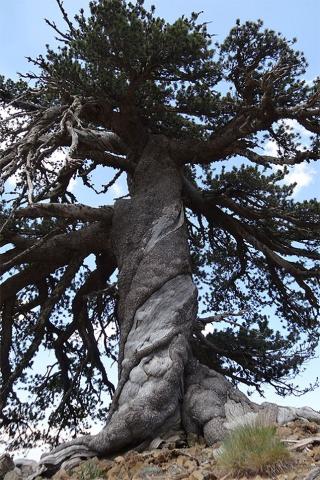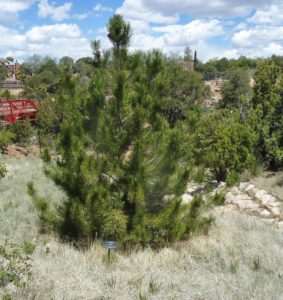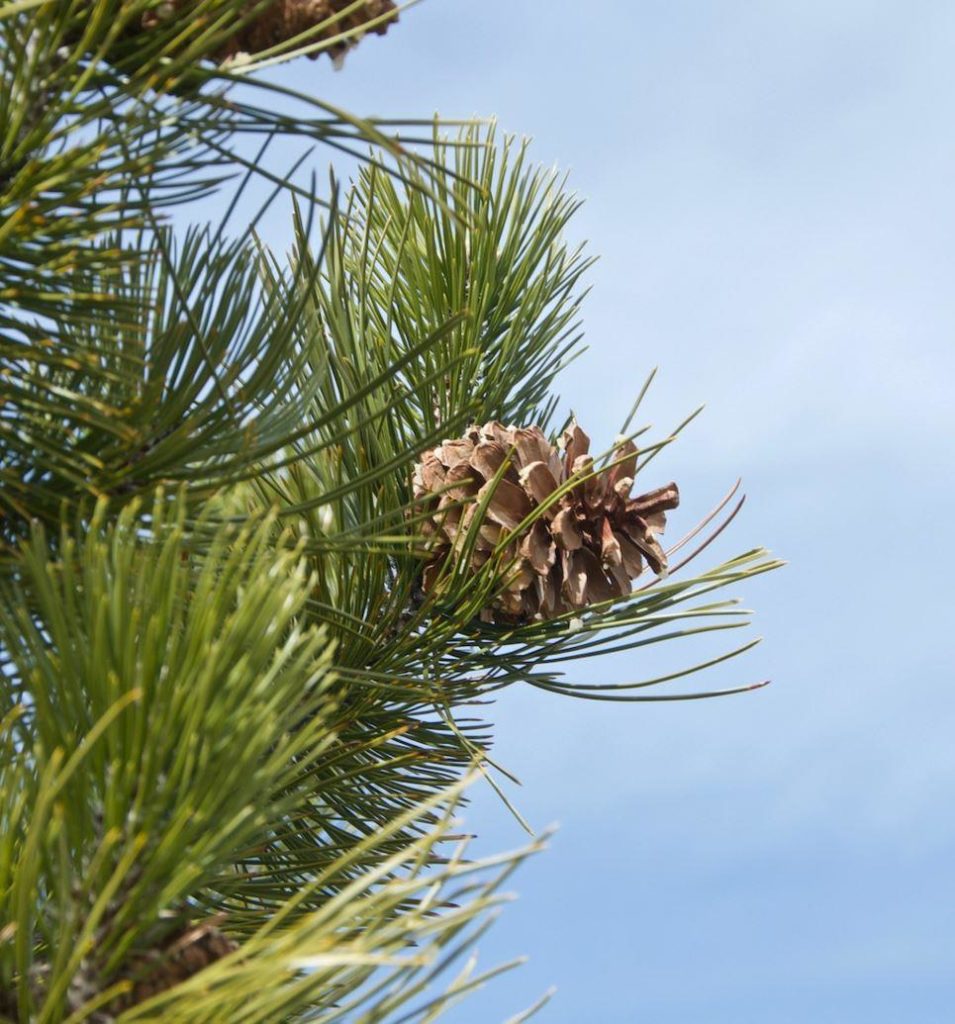Scientific name: Pinus heldreichii Christ
Synonym: Pinus leucodermis
Common name: Bosnian pine
Family: Pinaceae
Article by Susan Bruneni

“Adonis”, the 1,000+ year old Bosnian pine tree in Greece. Photo credit: http://www.arbnet.org/scientists-discover-grove-1000-year-old-trees-greece
When University of Stockholm graduate student Paul Krusic learned of a small ancient grove of Bosnian pines he was ecstatic. Krusic is an expert in tree-ring dating (dendrochronology) and specializes in the study of ancient trees to better understand climate change. In 2016, a multi-national team traveled deep into the Pindos Mountains in northern Greece to reach the dozen or so Bosnian pines, undisturbed for more than 1,000 years.
The oldest of the pines set down roots at least l,075 years ago. The core sample was not taken from the base, “so it’s definitely older. We’re just reporting the actual ring count,” said Krusic. Other trees in Europe that are clonal, reproducing asexually over and over again, may be older due to new individuals being genetically identical to original trees from thousands of years earlier, but these do not fit into the same category, or have not been tree-ring dated. In contrast to Europe, North America’s examples of long lived trees include the giant bristlecone pines of California which can reach 5,000 years old, western juniper in Sedona, Arizona, 3,000 years and the giant sequoias in California, 3,000 years. The 2,000-year-old redwood trees at California’s oldest state park, Big Basin Redwoods, were originally reported destroyed by this year’s fires. But they survived the fire and are alive, including the famous “Mother of the Forest.”
The oldest Bosnian pine in the Greek grove has been named “Adonis”, and is the oldest officially dated tree in Europe. Bosnian pines and their close cousin Austrian pines (Pinus nigra) are found throughout the Balkans and Southeastern Europe. The Bosnian pine has many of the same characteristics as the Austrian pine, but is more compact and symmetrical, with a more densely branched pyramidal shape. Krusic believes they survived by adapting to live in an ecosystem no one else wanted — even though civilization hustled and bustled just down the road and sheepherders frequented the area.
Fortunately they adapt well to new environments at the correct altitude. That’s good news, because you only have to travel to Museum Hill to see one, planted in the Santa Fe Botanical Garden. Granted, the specimen there is not quite as old as “Adonis”.

Bosnian pine in Santa Fe Botanical Garden
Originally the Botanical Garden at Museum Hill had hoped to plant several ponderosa pines together on the north side of the main path, between the main Orchard Gardens and the arroyo. Tracy Neal, a local horticulturist who has studied trees and landscaping in New Mexico for over 40 years, was a part of the Garden’s design team with landscape architect W. Gary Smith and agreed the pines would be a good choice. However three of the original trees did not survive past the first year, and there were no ponderosas available of the size needed to replace them. Gary decided, on Tracy’s recommendation, to replace them with Austrian and Bosinan pines. Austrian pines were well known in Santa Fe, but Bosnian pines were still uncommon, though they had performed well in tests at the New Mexico State University research station in Alcalde, NM. Their compact size, appealing bark, branching and needle color, as well as their adaptability to our climate and soils, made them suitable selections for our area.

Pinus heldrechii (Bosnian pine) cone. By Janice Tucker.
In its native habitat, it grows to 60-90 feet tall, but in cultivation typically grows to 30-40 feet tall. It is a member of the hard pine group, with needles in bundles of two, 1.8 inches to 3.9 inches long and 0.059–0.079 inches thick. Cones are 2.0–3.5 inches long, with thin, fragile scales; they are dark blue-purple before maturation, turning brown when ripe about 16–18 months after pollination. The 0.24–0.28 inch-long seeds have a wing less than one inch and are wind-dispersed. The Bosnian pine grows best at altitudes between 4900 to 8,200 feet; it will grow up to the alpine tree line. It is hardy down to at least -49 °F, and tolerant of severe wind.
Bosnian pine is a popular ornamental tree in parks and large gardens, giving reliable, steady, slow growth on a wide range of sites. It is admired for its neat, conical crown as well as its decorative purple cones. It is slow-growing, and very dense, making it suitable for privacy fences. Newer cultivars include a few very compact varieties under 10 feet. The Bosnian pine is able to adapt to extreme environmental conditions and high-altitude areas, and it has taken well to the terrain and climate of Santa Fe and northern New Mexico. In the south of Italy it is planted because it is less susceptible to pests than other pine species there. It has been found to be relatively pest-free so far in Santa Fe, as well.
References
“Bosnian pine”. Monrovia. Web. 17 Oct. 2020. Retrieved from: https://www.monrovia.com/plant-catalog/plants/1983/bosnian-pine/
D’estries, M. “Scientists discover grove of 1,000-year-old trees in Greece”. Mother Nature Network. 12 Sept. 2016. Retrieved from: http://www.mnn.com/earth-matters/climate-weather/blogs/grove-1000-year-old-trees-discovered-greece
“Pinus heldreichii”. Garden Explorer. Santa Fe Botanical Garden. Web. 17 Oct. 2020. Retrieved from: https://santafebotanicalgarden.gardenexplorer.org/taxon-562.aspx
“Pinus heldreichii”. Plant Finder. Missouri Botanical Garden. Web. 17 Oct. Retrieved from: http://www.missouribotanicalgarden.org/PlantFinder/PlantFinderDetails.aspx?taxonid=285051
“Pinus heldreichii”. Wikipedia: The Free Encyclopedia. Wikimedia Foundation, Inc. 24 Oct. 2020. Web. 17 Oct. 2020. Retrieved from: https://en.wikipedia.org/wiki/Pinus_heldreichii.


